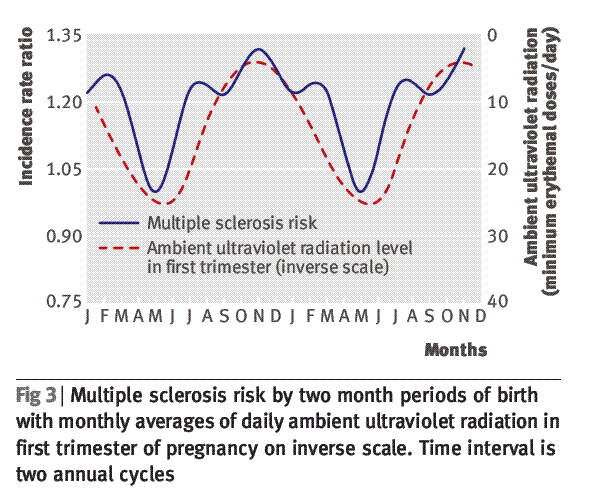Diseases correlated to month of birth – 2008
Human Responses to the Geophysical Daily, Annual and Lunar Cycles

Gray line shows how low Vitamin D level is in the Spring


CLICK HERE for details of graphs above
"Study was cited 418 times in Google Scholar by Nov 2022
The following is the portion of the 2008 text concerning MS and vitamin D
The incidence of multiple sclerosis (MS) varies with latitude. Ebers has co-ordinated a study [46] that examined more than 40,000 Canadian, British, Danish and Swedish patients with multiple sclerosis. The results show that in the Northern hemisphere, significantly fewer (8.5%) people with MS were born in November and significantly more (9.1%) were born in May. In the Southern hemisphere, the situation is reversed and November is the peak month and May the lowest. There are several clues as to the cause. An important study [47] compared the risk of two or more siblings having multiple sclerosis to the risk of its occurrence in both twins in a non-identical pair. There should be no difference, but non-identical twins do have a significantly higher risk of both having MS than non-twin siblings. This suggests that the pre-natal and post-natal environment affects the overall risk. Pinpointing the actual environmental factor has been problematic.
Correlations have been made between the incidence of MS, the availability of dietary vitamin D, and the availability of sunlight to drive vitamin D3 synthesis. In Japanese populations, who consume plenty of fish rich in vitamin D (90% of the Japanese vitamin D requirement comes from fish, 3% from eggs and 3% from milk), the MS prevalence is three per 100,000 population. MS has a very low frequency in equatorial regions where, it is argued, there is plenty of sunlight to drive vitamin D3 synthesis in the skin, whilst the incidence of MS increases dramatically with latitude in both hemispheres. In Scotland (in the north) and Tasmania (in the south), the prevalence is 250 per 100,000 population. Such arguments have also been used to explain two peculiar geographic anomalies on MS frequency, one in Switzerland with high MS rates at low altitudes and low MS rates at high altitudes, and one in Norway with a high MS prevalence inland and a lower MS prevalence along the coast. Ultraviolet light intensity is higher at high altitudes, resulting in a greater vitamin D3 synthetic rate, thereby accounting for low MS rates at higher altitudes. On the Norwegian coast, fish is consumed at high rates and fish oils are rich in vitamin D3 [48].
Full article is attached at the bottom of this page
See also VitaminDWiki
Season of Birth category listing has items along with related searches
Health problems are related to birth month - June 2015 many charts
7X more likely to have low birth weight babies when mother very low on vitamin D – March 2010
Is the variation in winter babies due to vitamin D – 2009
- from Wall Street Journal reporting on a 36 page medical article - 2008
Association between season of birth and suicide – perhaps vitamin D – Sept 2012
Multiple Sclerosis 23 % more likely if born in April vs. Oct – meta-analysis Nov 2012
Getting pregnant in May increases chance of premature birth by 10 percent – July 2013

Thanks to Rufus Greenbaum for finding articles on this in The Times (UK) and UK Daily Mail June 2011
and finding the original medical article which they referred to (attached below)
Daily Mail article on Birth Month - June 2011 sample table follows

See also web
- How Your Season of Birth Is Etched in Your Brain Wired Mag, March 2014
- looks at size of regions of brain vs season of birth: 550 MRI
- Noted that Spring babies more likely than others to develop schizophrenia later in life
